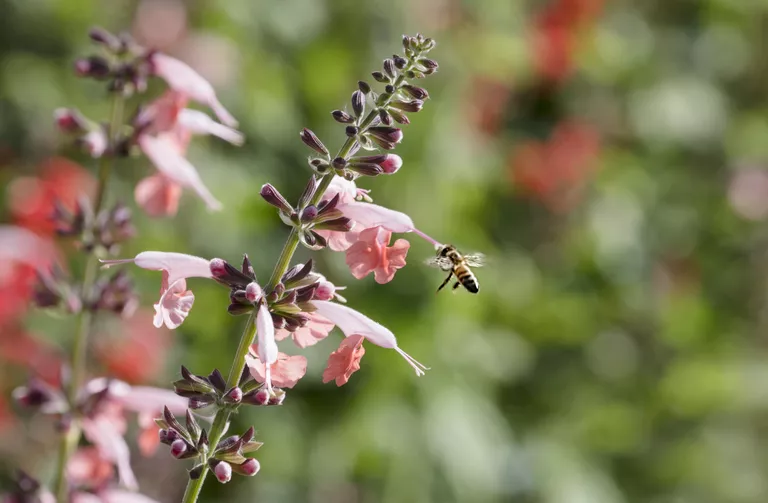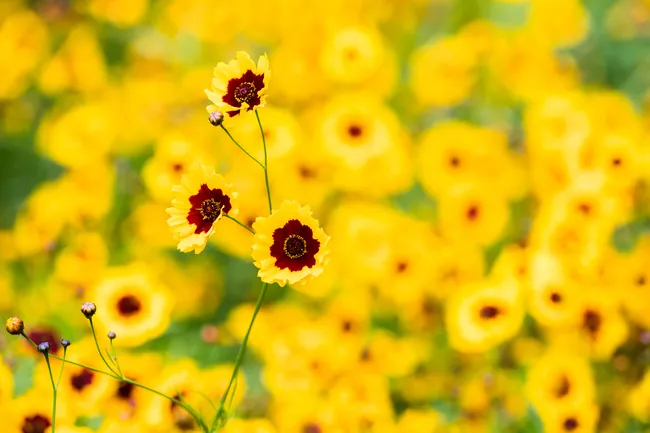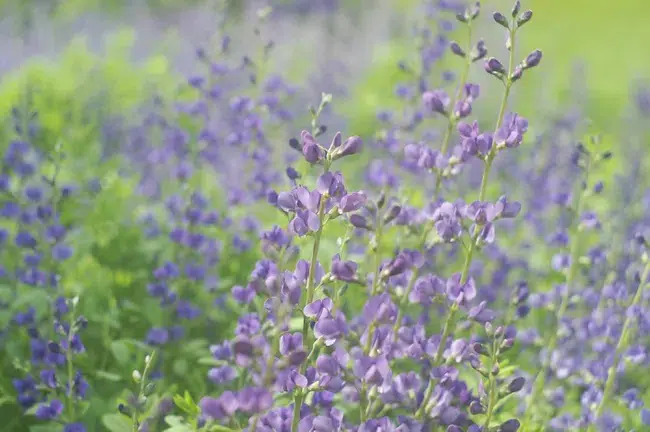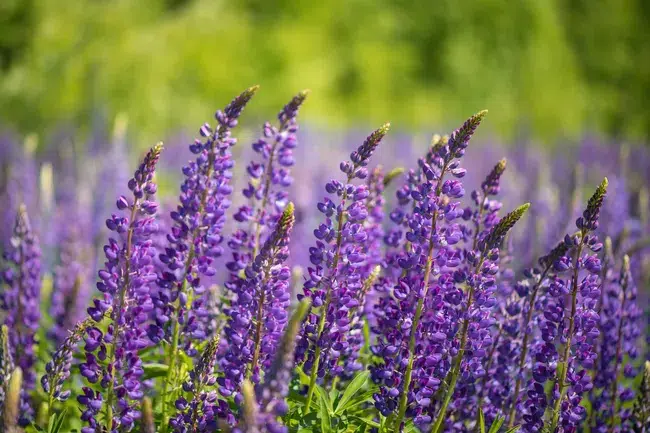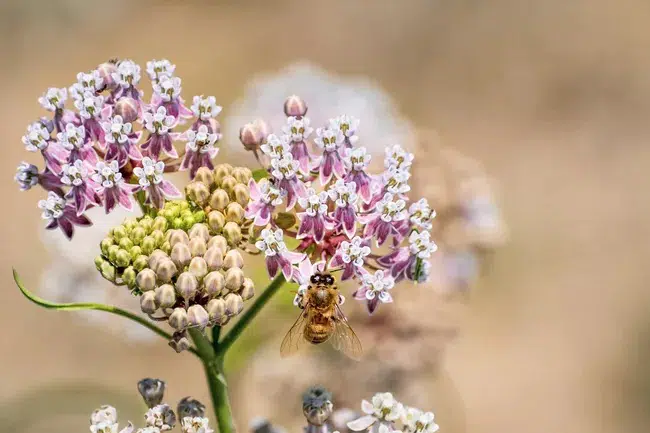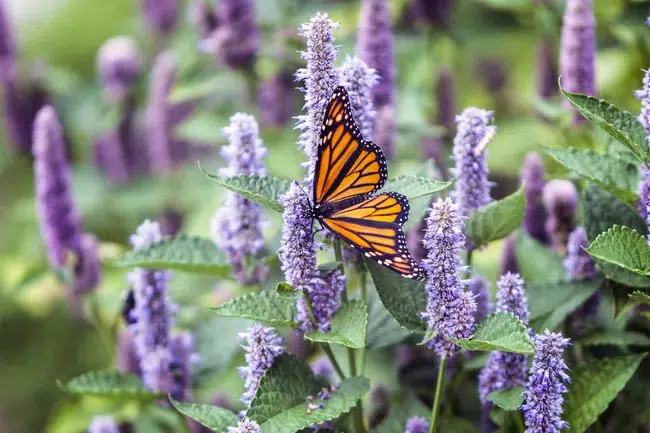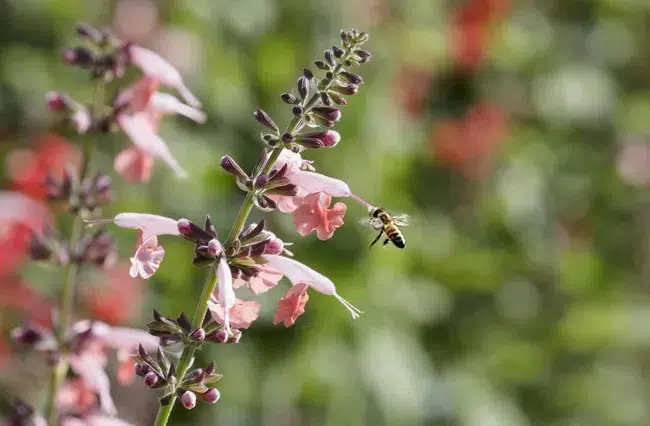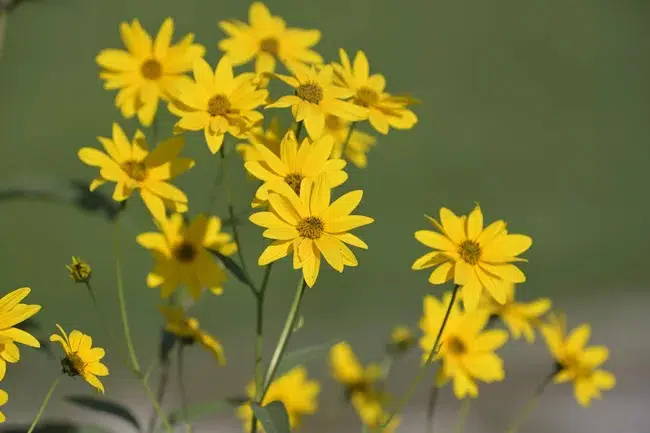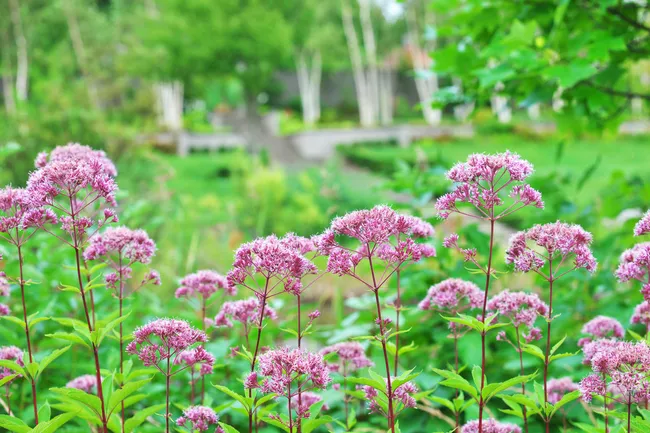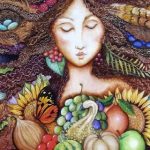by David M. Kuchta: Looking to support the bees by planting their favorite flowers in your garden this season?
When you imagine bees feeding, mid-summer blooms like sunflowers or bee balm may come to mind. But don’t overlook the early and late bloomers that can feed hungry bees when they first emerge in spring or are furiously trying to fill their larders before winter—when their survival is most at stake.
Whatever your soil type, climate zone, or sun exposure, there are hundreds of bee-friendly annuals and perennials that you can grow in your garden. This list of our favorite 15 flowers is organized loosely by bloom time.
Coreopsis (Coreopsis spp.)
Coreopsis are drought-tolerant and heat-loving. Birds will feed on their seeds, while pollinators are attracted to their long-blooming flowers. Coreopsis come in a variety of colors, usually yellow or reddish-orange. Blooms can start as early as late spring. Dead-head the flowers to stimulate a second bloom, but allow some to go to seed so that they self-sow.
- USDA Growing Zones: 4 to 8
- Sun Exposure: full sun to partial shade
- Soil Needs: rich, moist, well-draining soil
Penstemon (Penstemon spp.)
Penstemons have a long growing season, with some species blooming from early summer until the first frost. They can be short-lived, however, and can use protection with a mulch where winters are harsh. They produce tubular flowers in many colors, from lavender and pink to yellow and white. With over 200 species, they can be found in many habitats.
- USDA Growing Zones: 2 to 8, depending on the species
- Sun Exposure: full sun to partial shade
- Soil Needs: well-draining soil
Baptisia (Baptisia spp.)
Baptisia are members of the pea family, and look like overgrown pea plants. Commonly known as false indigo, they have long been used as dye plants. Their rattling dried pods make interesting additions to dried flower arrangements. Blue false indigo (B. australis) is the most common and opens in early summer.
- USDA Growing Zones: 3 to 9
- Sun Exposure: full sun to part shade
- Soil Needs: rich, moist, well-draining soil
Lupine (Lupinus spp.)
Not all lupine species are native to the Americas, but L. perennis, native to eastern North America and L. polyphyllus, native to the West, are the most common. Most lupines sold in garden centers are hybrids. Early summer bloomers, lupines don’t transplant easily but readily self-sow, so give them room to grow and leave them where they are.
- USDA Growing Zones: 3 to 7
- Sun Exposure: full sun
- Soil Needs: average, well-draining soil
Milkweed (Asclepias spp.)
There are over 100 species of native Ascelpias in North America, the most popular being Butterfly Milkweed (A. tuberosa) and Swamp Milkweed (A. incarnata), both blooming in midsummer. A. tuberosa is host to monarch butterfly larvae, though all species are bee-friendly. Let them self-sow, as they don’t like being divided or transplanted.
- USDA Growing Zones: 3 to 9
- Sun Exposure: full sun
- Soil Needs: average, well-draining soil
Sage (Salvia spp.)
Sages come in annual and perennial forms, almost all of them attractive to bees. The herb common sage (S. officinalis) is a perennial often grown as an annual, but true perennials include Azure Blue Sage (S. azurea) and Meadow Sage (S. pratensis), which bloom in mid to late summer.
- USDA Growing Zones: 4 to 9
- Sun Exposure: full sun to light shade
- Soil Needs: average to rich, well-draining soil
Bee Balm (Monarda spp.)
Bee Balm, or bergamot, is a cottage garden favorite, with unique spiky flower heads growing in clusters. In the mint family, it will readily spread by underground rhizomes, so divide the colonies to keep them in check if they are crowding out other species. This long-blooming perennial is popular with hummingbirds, butterflies, as well as, of course, bees.
USDA Growing Zones: 4 to 8
Sun Exposure: full sun to part shade
Soil Needs: moist, average, well-draining soil
Coneflower (Echinacea spp.)
Coneflowers are a common sight to prairies and gardens alike. Their daisy-shaped purple (or sometimes white) flowers with distinctive pincushion-shaped centers. Echinacea is also a name familiar to herbalists. Bees love their nectar when in bloom, but let coneflowers overwinter to allow birds to forage for seeds. What the birds miss will self-sow.
- USDA Growing Zones: 3 to 9
- Sun Exposure: full sun
- Soil Needs: well-draining soil of any type
Hyssop (Agastache spp.)
Anise hyssop is a member of the mint family. It is a perennial that can form clumps that self-sow, and also self-propagate by spreading underground roots. Their nearly foot-long spikes bloom from June to September, attracting hummingbirds, butterflies, and bees. Dry out the flowers to add to potpourris, or use the cut flowers in arrangements.
- USDA Growing Zones: 6 to 10
- Sun Exposure: Full sun or very light shade
- Soil Needs: well-draining soil
g (Lobelia spp.)
Lobelia erinus is a popular annual grown for its cascading blooms, but that species is native to South Africa. North American natives include Great Blue Lobelia (L. siphilitica) and Cardinal Flower (L. cardinalis), which grow along marshes, streams, or ponds, so keep their feet wet. They will bloom in mid to late summer.
- USDA Growing Zones: 3 to 9
- Sun Exposure: light to partial shade
- Soil Needs: rich, moist soil
Black-eyed Susan (Rudbeckia spp.)
Black-eyes Susans are easily recognizable, both by humans and bees. R. hirta is what we think of as Black-eyed Susans, but other species are also native to North America, including the giants R. maxima and R. laciniata, common in the Northeast.
- USDA Growing Zones: 3 to 9
- Sun Exposure: full sun to light shade
- Soil Needs: average to rich, evenly moist soil
Sunflower (Helianthus spp.)
Needing no introduction, the most common sunflower is the annual H. annuus, which can range from foot-tall varieties to towering giants that may need staking. In many regions, perennial species like H. angustifolius and H. maximiliani will bloom in late summer, attracting bees to their pollen, then birds and small mammals to their seeds.
- USDA Growing Zones: 3 to 8
- Sun Exposure: full sun
- Soil Needs: average, moist, well-draining soil
Asters (Symphyotrichum spp.)
While there are annual asters, perennial asters such as New England Asters (S. novae-angliae) are a familiar site in many gardens. Most asters bloom in late summer and fall, after most other flowers have lost their luster. Give them good air circulation to prevent powdery mildew, but otherwise these are low-maintenance, long-lasting gifts to any garden.
- USDA Growing Zones: 3 to 8 (depending on species)
- Sun Exposure: full sun (some species in partial shade)
- Soil Needs: rich, well-draining soil
Goldenrod (Solidago spp.)
Goldenrods signal the imminent arrival of fall. There are species native to every region in North America, from the classic S. rugosa, common to the East Coast, to S. velutina ssp. californica and S. canadensis along the West Coast. Despite common misconception, goldenrod does not cause hay fever, so let the bees enjoy their late summer blooms.
- USDA Growing Zones: 4 to 9
- Sun Exposure: full sun
- Soil Needs: average, moist, well-draining soil
Joe-Pye Weed (Eutrochium spp.)
Over 40 species of Joe-Pye Weed are native to North America, while dwarf varieties are cultivated and available in garden centers. Cultivars should be propagated by cuttings or division, but standard species will self-sow. Blooming in early fall, after most other bloomers have given up for the year, their showy, fuzzy flowers are like a late-night snack for bees before they, too, retire for the year.
- USDA Growing Zones: 4 to 9
- Sun Exposure: full sun to partial shade
- Soil Needs: average, well-draining soil







